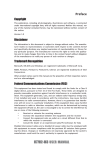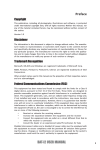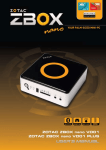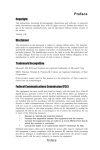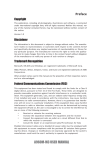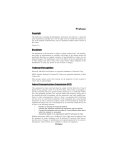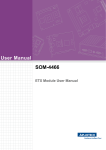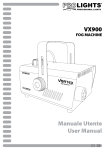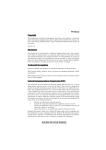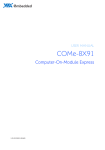Download chapter 1 new.pmd
Transcript
Preface Copyright This publication, including all photographs, illustrations and software, is protected under international copyright laws, with all rights reserved. Neither this manual, nor any of the material contained herein, may be reproduced without written consent of the author. Version 1.0 Disclaimer The information in this document is subject to change without notice. The manufacturer makes no representations or warranties with respect to the contents hereof and specifically disclaims any implied warranties of merchantability or fitness for any particular purpose. The manufacturer reserves the right to revise this publication and to make changes from time to time in the content hereof without obligation of the manufacturer to notify any person of such revision or changes. Trademark Recognition Microsoft, Windows and Windows 7 are registered trademarks of Microsoft Corp. VIA ® are registered trademarks of VIA Corporation. Other product names used in this manual are the properties of their respective owners and are acknowledged. Federal Communications Commission (FCC) This equipment has been tested and found to comply with the limits for a Class B digital device, pursuant to Part 15 of the FCC Rules. These limits are designed to provide reasonable protection against harmful interference in a residential installation. This equipment generates, uses, and can radiate radio frequency energy and, if not installed and used in accordance with the instructions, may cause harmful interference to radio communications. However, there is no guarantee that interference will not occur in a particular installation. If this equipment does cause harmful interference to radio or television reception, which can be determined by turning the equipment off and on, the user is encouraged to try to correct the interference by one or more of the following measures: • • • • Reorient or relocate the receiving antenna Increase the separation between the equipment and the receiver Connect the equipment onto an outlet on a circuit different from that to which the receiver is connected Consult the dealer or an experienced radio/TV technician for help Shielded interconnect cables and a shielded AC power cable must be employed with this equipment to ensure compliance with the pertinent RF emission limits governing this device. Changes or modifications not expressly approved by the system’s manufacturer could void the user’s authority to operate the equipment. VX900-I USER MANUAL Declaration of Conformity This device complies with part 15 of the FCC rules. Operation is subject to the following conditions: • This device may not cause harmful interference. This device must accept any interference received, including interference that may cause undesired operation. This device is in conformity with the following EC/EMC directives: Limits and methods of mesurement of radio disturbance char EN 55022 acteristics of information technology equipment EN 61000-3-2 Disturbances in supply systems caused • EN 61000-3-3 Disturbances in supply systems caused by household appliances and similar electrical equipment “ Voltage fluctuations” EN 55024 Information technology equipment-Immunity characteristicsLimits and methods of measurement Safety for information technology equipment including electrical business equipment EN 60950 CE marking Canadian Department of Communications This class B digital apparatus meets all requirements of the Canadian Interferencecausing Equipment Regulations. Cet appareil numérique de la classe B respecte toutes les exigences du Réglement sur le matériel brouilieur du Canada. About the Manual The manual consists of the following: ii Chapter 1 Introducing the Motherboard Describes features of the motherboard. H page 1 Chapter 2 Installing the Motherboard Describes installation of motherboard components. H page 7 Chapter 3 Using BIOS Provides information on using the BIOS Setup Utility. H page 23 Chapter 4 Describes the motherboard Using the Motherboard Software software. H page 41 Chapter 5 Trouble Shooting H page 45 Provides basic shooting tips. VX900-I USER MANUAL trouble TABLE OF CONTENTS Preface i Chapter 1 1 Introducing the Motherboard 1 Introduction...........................................................................................1 Pakage Contents..................................................................................1 Specifications......................................................................................2 Motherboard Components................................................................4 I/O Ports...............................................................................................6 Chapter 2 7 Installing the Motherboard 7 Safety Precautions..............................................................................7 Installing the Motherboard in a Chassis.......................................7 Checking Jumper Settings..................................................................8 Installing Hardware...........................................................................9 Installing Memory Modules.....................................................9 Installing Add-on Cards..........................................................10 Connecting Optional Devices.................................................12 Installing a SATA Hard Drive...................................................17 Connecting Case Components........................................................18 Front Panel Header................................................................20 Chapter 3 23 Using BIOS 23 About the Setup Utility......................................................................23 The Standard Configuration........................ ...........................23 Entering the Setup Utility.......................................................24 Resetting the Default CMOS Values.....................................25 Using BIOS.........................................................................................25 BIOS Navigation Keys..............................................................25 Standard CMOS Setup................................................................26 Advanced Setup......................................................................28 Advanced Chipset Setup.........................................................30 Integrated Peripherals...........................................................31 Power Management Setup.....................................................32 PCI/Plug and Play Setup.........................................................33 PC Health Status....................................................................34 Frequency/Voltage Control..................................................36 Load Default Settings...........................................................37 VX900-I USER MANUAL iii Supervisor Password.............................................................37 User Password......................................................................38 Save & Exit Setup....................................................................39 Exit Without Saving.....................................................................39 Updating the BIOS......................................................................40 Chapter 4 41 Using the Motherboard Software 41 Auto-installing under Windows XP/Vista/7.................................41 Running Setup........................................................................41 Manual Installation..........................................................................43 Chapter 5 45 Trouble Shooting 45 Start up problems during assembly..............................................45 Start up problems after prolong use............................................46 Maintenance and care tips..............................................................46 Basic Troubleshooting Flowchart.....................................................47 iv VX900-I USER MANUAL Introduction Chapter 1 Chapter 1 Introducing the Motherboard Thank you for choosing the VX900-I motherboard. This motherboard is a high performance, enhanced function motherboard with onboard VIA® L2007 Processor. This motherboard is based on VIA® VX900(colay VX900H) Express Chipset for best desktop platform solution. It supports up to 8 GB of system memory with dual channel DDR3 1066 MHz. It also supports one PCI slot. It implements an EHCI compliant interface that provides eight USB 2.0 ports (four USB 2.0 ports and two USB 2.0 headers support additional four USB 2.0 ports). This motherboard integrates a Serial ATA host controller, supporting two SATA ports with maximum transfer rate up to 3Gb/s each. The motherboard is equipped with advanced full set of I/O ports in the rear panel, including PS/2 mouse and PS/2 keyboard connectors, one HDMI port, one COM port, one VGA port, one LAN connector, four USB 2.0 ports, and audio jacks for microphone, line-in and line-out. Package Contents Your motherboard package ships with the following items: VX900-I Motherboard User Manual DVD I/O Shield 2 SATA 3Gb/s Cables The package contents above are for reference only, please take the actual package items as standard. VX900-I USER MANUAL 1 Chapter 1 Specifications • • Onboard VIA ® Single Core L2007 1.6G(colay Dual Core 4300/ 4350) processor Supports FSB 800/533/400 MHz 25W Chipset • VIA ® VX900(Colay VX900H) Chipset Memory • • • Dual-channel DDR3 memory architecture 2 x 240-pin DDR3 DIMM sockets support up to 8 GB Supports DDR3 1066 MHz DDR3 SDRAM CPU • Note: Please go to ECS website for the latest Memory support list. 2 Expansion Slots • 1 x PCI slot Storage • Audio • Supported by VIA® VX900(Colay VX900H) Express Chipset - 2 x Serial ATA 3Gb/s devices - RAID 1.0 configuration VIA VT1705CE - 6 Channel High Definiton Audio Codec - Compliant with HD audio specification LAN • Realtek 8111E Gigabit Lan(Co-lay 8105E) - 10/100/1000 Fast Ethernet Controller - Wake-on-LAN and remote wake-up support Realtek 8105E - 10/100 Fast Ethernet Controller - Wake-on-LAN and remote wake-up support Rear Panel I/O • • • • • • • 1 x PS/2 keyboard and PS/2 mouse connectors 1 x D-Sub port (VGA) 1 x COM port 1 x HDMI port 4 x USB 2.0 ports 1 x RJ45 LAN connector 1 x Audio port (1x Line out, 1x Mic_in Rear) Internal I/O Connectors & Headers 1 1 1 2 2 2 1 1 1 1 1 1 1 1 1 • • • • • • • • • • • • • • • x 24-pin ATX Power Supply connector x 3-pin CPU_FAN connector x 3-pin SYS_FAN connector x USB 2.0 headers support additional four USB 2.0 ports x Serial ATA 3Gb/s connectors x COM headers x LVDS connector (optional) x Case open header x Front Panel audio header x Front Panel switch/LED header x Speaker header x Parallel port header (LPT) x CLR_CMOS header x Front panel USB power select jumper x Rear USB/PS2 power select jumper VX900-I USER MANUAL • Form Factor • AMI BIOS with 8Mb SPI Flash ROM - Supports Plug and Play, S1/STR(S3)/STD(S4) - Supports Hardware Monitor - Supports ACPI 3.0 & DMI - Supports Audio, LAN, can be disabled in BIOS - F11 hot key for boot up devices option Mini-ITX Size, 170mm x 170mm VX900-I USER MANUAL Chapter 1 System BIOS 3 Chapter 1 4 Motherboard Components VX900-I USER MANUAL LABEL 1. CPU 2. CPU_FAN 3. DIMM_1~2 4. SYS_FAN 5. ATX_POWER 6. F_PANEL 7. SPI_DEBUG 8. SPK 9. CLR_CMOS 10. PCI 11. USBPWR_F 12. F_AUDIO 13. SATA1~2 14. F_USB1~2 15. USBPWR_R 16. NB 17. LVDS 18. LPT 19. COM1~2 20. CASE COMPONENTS Onboard VIA® L2007 3-pin CPU cooling fan connector 240-pin DDR3 Module slots 3-pin system cooling fan connector Standard 24-pin ATX power connector Front panel switch/LED header SPI Debug header - for factory use only Speaker header Clear CMOS jumper 32-bit add-on card slot Front panel USB power select jumper Front panel audio header Serial ATA 3.0 Gb/s connectors Front panel USB 2.0 headers Rear USB/PS2 power select jumper VX900 (colay VX900H) 30-Pin one-channel LVDS connector (optional) Printer Header Onboard serial port headers CASE open header VX900-I USER MANUAL Chapter 1 Table of Motherboard Components 5 Chapter 1 I/O Ports 1. PS/2 Mouse(green) Use the upper PS/2 port to connect a PS/2 mouse. 2. PS/2 Keyboard(purple) Use the lower PS/2 port to connect a PS/2 keyboard. 3. HDMI Port You can connect the display device to the HDMI port. 4. COM Port Use the COM port to connect serial devices such as Mouse or fax/modems. 5. VGA Port Connect your monitor to the VGA port. 6. USB 2.0 Ports Use the USB 2.0 ports to connect USB 2.0 devices. 7. LAN Port Connect an RJ-45 jack to the LAN port to connect your computer to the Network. LAN LED Activity LED Link LED Status Description OFF Orange blinking OFF Green No data Active No link Link Link LED LAN Port 8. Line-in(blue) It can be connected to an external CD/DVD player, Tape player or other audio devices for audio input. 9. Line-out(lime) It is used to connect to speakers or headphones. 10. Microphone(pink) It is used to connect to a microphone. 6 VX900-I USER MANUAL Chapter 2 Installing the Motherboard Follow these safety precautions when installing the motherboard: • • • • Wear a grounding strap attached to a grounded device to avoid damage from static electricity. Discharge static electricity by touching the metal case of a safely grounded object before working on the motherboard. Leave components in the static-proof bags. Always remove the AC power by unplugging the power cord from the power outlet before installing or removing the motherboard or other hardware components. Chapter 2 2-1. Safety Precautions 2-2. Installing the motherboard in a Chassis This motherboard carries a Mini ITX form factor of 170 x 170 mm. Choose a chassis that accommodates this from factor. Make sure that the I/O template in the chassis matches the I/O ports installed on the rear edge of the motherboard. Most system chassis have mounting brackets installed in the chassis, which corresponds to the holes in the motherboard. Place the motherboard over the mounting brackets and secure the motherboard onto the mounting brackets with screws. Do not over-tighten the screws as this can stress the motherboard. VX900-I USER MANUAL 7 2-3. Checking Jumper Settings The following illustration shows the location of the motherboard jumpers. Pin 1 is labeled. Chapter 2 1. To avoid the system instability after clearing CMOS, we recommend users to enter the main BIOS setting page to “Load Default Settings” and then “Save and Exit Setup”. 2. Make sure the power supply provides enough 5VSB voltage before selecting the 5VSB function. 3. It is required that users place the USBPWR_F1 & USBPWR_R1 cap onto 2-3 pin rather than 1-2 pin as default if you want to wake up the computer by USB/ PS2 KB/Mouse. 8 VX900-I USER MANUAL 2-4. Installing Hardware • • • • This motherboard accommodates two memory modules. It can support two 240-pin DDR3 1066. Do not remove any memory module from its antistatic packaging until you are ready to install it on the motherboard. Handle the modules only by their edges. Do not touch the components or metal parts. Always wear a grounding strap when you handle the modules. You must install at least one module in any of the two slots. Total memory capacity is 8 GB. Refer to the following to install the memory modules. Chapter 2 2-4-1. Installing Memory Modules A. Push the latches on each side of the DIMM slot down. B. Install the DIMM module into the slot and press it firmly down until it seats correctly. Check that the cutouts on the DIMM module edge connector match the notches in the DIMM slot. C. The slot latches are levered upwards and latch on to the edges of the DIMM. VX900-I USER MANUAL 9 2-4-2. Installing Add-on Cards The slots on this motherboard are designed to hold expansion cards and connect them to the system bus. Expansion slots are a means of adding or enhancing the motherboard’s features and capabilities. With these efficient facilities, you can increase the motherboard’s capabilities by adding hardware that performs tasks that are not part of the basic system. Chapter 2 PCIE Slot The PCI Express x1 slot is fully compliant to the PCI Express Base Specification revision 2.0. Before installing an add-on card, check the documentation for the card carefully. If the card is not Plug and Play, you may have to manually configure the card before installation. 10 VX900-I USER MANUAL 1 Remove a blanking plate from the system case corresponding to the slot you are going to use. 2 Install the edge connector of the add-on card into the expansion slot. Ensure that the edge connector is correctly seated in the slot. 3 Secure the metal bracket of the card to the system case with a screw. 1. For some add-on cards, for example graphics adapters and network adapters, you have to install drivers and software before you can begin using the add-on card. Chapter 2 Follow these instructions to install an add-on card: 2. The onboard PCI interface does not support 64-bit SCSI cards. Please refer the following illustrations to install the add-on card: Install the VGA Card in the PCI slot VX900-I USER MANUAL 11 2-4-3. Connecting Optional Devices Refer to the following for information on connecting the motherboard’s optional devices: Chapter 2 No. Components No. 1 F_AUDIO 5 Components LPT 2 SATA1~2 6 COM 3 F_USB1~2 7 CASE 4 LVDS (optional) —— —— 1. F_AUDIO: Front Panel Audio Header The front panel audio header allows the user to install auxiliary front-oriented microphone and line-out ports for easier access. This header supports HD audio by default. If you want connect an AC’ 97 front panel audio to HD onboard headers, please set as below picture. 12 VX900-I USER MANUAL AC’ 97 Audio Configuration: To enable the front panel audio conne-ctor to support AC97 Audio mode. Chapter 2 If you use AC’ 97 Front Panel, please tick off the option of “ Disabled Front Panel Detect ”. If you use HD Audio Front Panel, please don’ t tick off “Disabled Front Panel Detect ” . * For reference only If you use AC’ 97 Front Panel, please don’ t tick off “Using Front Jack Detect ”. If you use HD Audio Front Panel, please tick off the option of “Using Front Jack Detect ”. * For reference only VX900-I USER MANUAL 13 2. SATA1~2: Serial ATA connectors SATA1/2 connectors support the Serial ATA 3.0Gb/s device. Simpler disk drive cabling and easier PC assembly. It eliminates limitations of the current Parallel ATA interface. But maintains register compatibility and sofeware compatibility with Parallel ATA. Chapter 2 3. F_USB1~2: Front Panel USB 2.0 headers The motherboard has two USB 2.0 headers supporting four USB 2.0 ports. Additionally, some computer cases have USB ports at the front of the case. If you have this kind of case, use auxiliary USB connector to connect the front-mounted ports to the motherboard. Please make sure that the USB cable has the same pin assignment as indicated above. A different pin assignment may cause damage or system hangup. 14 VX900-I USER MANUAL Chapter 2 4. LVDS: LVDS connector (optional) 5. LPT: Onboard parallel port Header This is a header that can be used to connect to the printer, scanner or other devices. VX900-I USER MANUAL 15 6. COM: Onboard serial port header Connect a serial port extension bracket to this header to add a serial port to your system. Chapter 2 7. CASE: Chassis Intrusion Detect Header This detects if the chassis cover has been removed. This function needs a chassis equipped with instrusion detection switch and needs to be enabled in BIOS. 16 VX900-I USER MANUAL 2-4-4. Installing a SATA Hard Drive This section describes how to install a SATA Hard Drive. Your motherboard features two SATA connectors supporting a total of four drives. SATA refers to Serial ATA (Advanced Technology Attachment) is the standard interface for the IDE hard drives which are currently used in most PCs. These connectors are well designed and will only fit in one orientation. Locate the SATA connectors on the motherboard and follow the illustration below to install the SATA hard drives. Installing Serial ATA Hard Drives To install the Serial ATA (SATA) hard drives, use the SATA cable that supports the Serial ATA protocol. This SATA cable comes with a SATA power cable. You can connect either end of the SATA cable to the SATA hard drive or the connector on the motherboard. Chapter 2 About SATA Connectors Refer to the illustration below for proper installation: 1 2 3 Attach either cable end to the connector on the motherboard. Attach the other cable end to the SATA hard drive. Attach the SATA power cable to the SATA hard drive and connect the other end to the power supply. * For reference only VX900-I USER MANUAL 17 2-4-7. Connecting Case Components After you have installed the motherboard into a case, you can begin connecting the motherboard components. Refer to the following: Chapter 2 No. Components 1 CPU_FAN 2 SYS_FAN 3 ATX_POWER 4 F_PANEL 5 SPK 1&2. CPU_FAN (CPU cooling FAN Power Connector) & SYS_FAN (System Cooling FAN Power Connector) Connect the CPU cooling fan cable to CPU_FAN. Connect the system cooling fan connector to SYS_FAN. Users please note that the fan connector supports the CPU cooling fan of 1.1A ~ 2.2A (26.4W max) at +12V. 18 VX900-I USER MANUAL 3. ATX_POWER (ATX 24-pin Power Connector) Chapter 2 Connect the standard power supply connector to ATX_POWER. Connecting 24-pin power cable The ATX 24-pin connector allows you to connect to ATX v2.x power supply. With ATX v2.x power supply, users please note that when installing 24-pin power cable, the latches of power cable and the ATX match perfectly. 24-pin power cable VX900-I USER MANUAL 19 4. Front Panel Header The front panel header (F_PANEL) provides a standard set of switch and LED headers commonly found on ATX or Micro ATX cases. Refer to the table below for information: Chapter 2 Hard Drive Activity LED Connecting pins 1 and 3 to a front panel mounted LED provides visual indication that data is being read from or written to the hard drive. For the LED to function properly, an IDE drive should be connected to the onboard IDE interface. The LED will also show activity for devices connected to the SCSI (hard drive activity LED) connector. Power/Sleep/Message waiting LED Connecting pins 2 and 4 to a single or dual-color, front panel mounted LED provides power on/off, sleep, and message waiting indication. Reset Switch Supporting the reset function requires connecting pin 5 and 7 to a momentary-contact switch that is normally open. When the switch is closed, the board resets and runs POST. Power Switch Supporting the power on/off function requires connecting pins 6 and 8 to a momentary-contact switch that is normally open. The switch should maintain contact for at least 50 ms to signal the power supply to switch on or off. The time requirement is due to internal de-bounce circuitry. After receiving a power on/off signal, at least two seconds elapses before the power supply recognizes another on/off signal. 20 VX900-I USER MANUAL 5. SPK: Speaker Chapter 2 Connect the case speaker cable to SPK. This concludes Chapter 2. The next chapter covers the BIOS. VX900-I USER MANUAL 21 Memo Chapter 2 22 VX900-I USER MANUAL Chapter 3 Using BIOS About the Setup Utility The BIOS (Basic Input and Output System) Setup Utility displays the system’s configuration status and provides you with options to set system parameters. The parameters are stored in battery-backed-up CMOS RAM that saves this information when the power is turned off. When the system is turned back on, the system is configured with the values you stored in CMOS. The BIOS Setup Utility enables you to configure: • Hard drives, diskette drives and peripherals • Video display type and display options • Password protection from unauthorized use • Power Management features Chapter 3 The computer uses the latest “American Megatrends Inc. ” BIOS with support for Windows Plug and Play. The CMOS chip on the motherboard contains the ROM setup instructions for configuring the motherboard BIOS. The settings made in the Setup Utility affect how the computer performs. Before using the Setup Utility, ensure that you understand the Setup Utility options. This chapter provides explanations for Setup Utility options. The Standard Configuration A standard configuration has already been set in the Setup Utility. However, we recommend that you read this chapter in case you need to make any changes in the future. This Setup Utility should be used: • when changing the system configuration • when a configuration error is detected and you are prompted to make changes to the Setup Utility • when trying to resolve IRQ conflicts • when making changes to the Power Management configuration • when changing the password or making other changes to the Security Setup Entering the Setup Utility When you power on the system, BIOS enters the Power-On Self Test (POST) routines. POST is a series of built-in diagnostics performed by the BIOS. After the POST routines are completed, the following message appears: Press DEL to enter SETUP VX900-I USER MANUAL 23 Press the delete key to access BIOS Setup Utility. CMOS Setup Utility - Copyright (C) 1985-2005, American Megatrends, Inc. Standard CMOS Setup Advanced Setup Advanced Chipset Setup Integrated Peripherals Power Management Setup PCI/PnP Setup PC Health Status : Move Enter : Select F1:General Help Frequency/Voltage Control Load Default Settings Supervisor Password User Password Save & Exit Setup Exit Without Saving +/-/: Value F10: Save ESC: Exit F9: Load Default Settings v02.59 (C)Copyright 1985-2005, American Megatrends, Inc. Chapter 3 Resetting the Default CMOS Values When powering on for the first time, the POST screen may show a “CMOS Settings Wrong” message. This standard message will appear following a clear CMOS data at factory by the manufacturer. You simply need to Load Default Settings to reset the default CMOS values. Note: Changes to system hardware such as different CPU, memories, etc. may also trigger this message. CMOS Setup Utility - Copyright (C) 1985-2005, American Megatrends, Inc. Standard CMOS Setup Frequency/Voltage Control Advanced Setup Load Default Settings Advanced Chipset Setup Supervisor Password Integrated Peripherals User Password Power Management Setup Save & Exit Setup PCI/PnP Setup Exit Without Saving Load Default Settings? PC Health Status [OK] [Cancel] : Move Enter : Select +/-/: Value F10: Save ESC: Exit F1:General Help F9: Load Default Settings v02.59 (C)Copyright 1985-2005, American Megatrends, Inc. 24 VX900-I USER MANUAL Using BIOS When you start the Setup Utility, the main menu appears. The main menu of the Setup Utility displays a list of the options that are available. A highlight indicates which option is currently selected. Use the cursor arrow keys to move the highlight to other options. When an option is highlighted, execute the option by pressing <Enter>. Some options (marked with a triangle ) lead to submenus that enable you to change the values for the option. Use the cursor arrow keys to scroll through the items in the submenu. In this manual, default values are enclosed in parenthesis. Submenu items are denoted by a triangel . The default BIOS setting for this motherboard apply for most conditions with optimum performance. We do not suggest users change the default values in the BIOS setup and take no responsibility to any damage caused by changing the BIOS settings. Chapter 3 Some options lead to pop-up dialog boxes that prompt you to verify that you wish to execute that option. Other options lead to dialog boxes that prompt you for information. BIOS Navigation Keys The BIOS navigation keys are listed below: KEY FUNCTION ESC Exits the current menu +/Enter Modifies the selected field’s values Select F9 Loads an optimized setting for better performance Scrolls through the items on a menu F10 Saves the current configuration and exits setup F1 Displays a screen that describes all key functions For the purpose of better product maintenance, the manufacture reserves the right to change the BIOS items presented in this manual. The BIOS setup screens shown in this chapter are for reference only and may differ from the actual BIOS. Please visit the manufacture’s website for updated manual. VX900-I USER MANUAL 25 Standard CMOS Setup This option displays basic information about your system. CMOS Setup Utility - Copyright (C) 1985-2005, American Megatrends, Inc. Standard CMOS Setup Date Time Help Item Fri 02/03/2012 00 : 04 : 24 SATA1 SATA2 Hard Disk ATAPI CDROM Use [ENTER], [TAB] or [SHIFT-TAB] to select a field. Use [+] or [-] to configure system Date. Chapter 3 : Move Enter : Select F1: General Help +/-/: Value F10: Save ESC: Exit F9: Load Default Settings Date & Time The Date and Time items show the current date and time on the computer. If you are running a Windows OS, these items are automatically updated whenever you make changes to the Windows Date and Time Properties utility. SATA1~2 This motherboard supports two SATA channels and each channel allows one SATA device to be installed. Use these items to configure each device on the SATA channel. SATA1 Scroll to this item and press <Enter> to view the following screen: CMOS Setup Utility - Copyright (C) 1985-2005, American Megatrends, Inc. SATA1 : Primary IDE Master Device Vendor Size LBA Mode Block Mode PIO Mode Async DMA Ultra DMA S.M.A.R.T. Help Item : Hard Disk : HDS728080PLA380 : 82.3GV : Supported : 16Sectors :4 : MultiWord DMA-2 : Ultra DMA-6 : Supported Type LBA/Large Mode Block (Multi-Sector Transfer PIO Mode DMA Mode S.M.A.R.T. 32Bit Data Transfer Select the type of device connected to the system. Auto Auto Auto Auto Auto Auto Enabled : Move Enter : Select F1: General Help 26 +/-/: Value F10: Save ESC: Exit F9: Load Default Settings VX900-I USER MANUAL SATA2 Scroll to this item and press <Enter> to view the following screen: CMOS Setup Utility - Copyright (C) 1985-2005, American Megatrends, Inc. SATA2 : Primary IDE Slave Type PIO Mode DMA Mode : : : : : : Help Item ATAPI CDROM SONY DVD RW DRU-190S Supported 4 MultiWord DMA-2 Ultra DMA-5 Select the type of device connected to the system. Auto Auto Auto : Move Enter : Select F1: General Help +/-/: Value F10: Save ESC: Exit F9: Load Default Settings Type (Auto) Use this item to configure the type of the IDE device that you specify. If the feature is enabled, it will enhance hard disk performance by reading or writing more data during each transfer. Chapter 3 Device Vendor LBA Mode PIO Mode Async DMA Ultra DMA LBA/Large Mode (Auto) Use this item to set the LAB/Large mode to enhance hard disk performance by optimizing the area the hard disk is visited each time. Block (Multi-Sector Transfer) (Auto) If the feature is enabled, it will enhance hard disk performance by reading or writing more data during each transfer. PIO Mode (Auto) Use this item to set the PIO mode to enhance hard disk performance by optimizing the hard disk timing. DMA Mode (Auto) DMA capability allows user to improve the transfer-speed and data-integrity for compatible IDE devices. S.M.A.R.T. (Auto) The S.M.A.R.T. (Self-Monitoring, Analysis and Reporting Technology) system is a diagnostics technology that monitors and predicts device performance. S.M.A.R.T. software resides on both the disk drive and the host computer. 32Bit Data Transfer (Enabled) Use this item to set the onboard SATA-IDE channel to be disabled, IDE, or RAID. Press <Esc> to return to the Standard CMOS Setup page. Press <Esc> to return to the main menu setting page. VX900-I USER MANUAL 27 Advanced Setup This page sets up more advanced information about your system. Handle this page with caution. Any changes can affect the operation of your computer. CMOS Setup Utility - Copyright (C) 1985-2005, American Megatrends, Inc. Advanced Setup Quick Power on Self Test Boot Up Numlock Status APIC Mode 1st Boot Device 2nd Boot Device 3rd Boot Device Hard Disk Drives CD/DVD Drives Boot Other Device Enabled On Enabled HDS728080PLA380 SONY DVD RW DRU-190 Removable Dev. Press Enter Press Enter Yes Chapter 3 : Move Enter : Select F1: General Help Help Item Allows BIOS to skip certain tests while booting. This will decrease the time needed to boot the system. +/-/: Value F10: Save ESC: Exit F9: Load Default Settings Quick Power on Self Test (Enabled) Enable this item to shorten the power on testing (POST) and have your system start up faster. You might like to enable this item after you are confident that your system hardware is operating smoothly. Boot Up Numlock Status (On) This item defines if the keyboard Num Lock key is active when your system is started. APIC Mode (Enabled) This item allows you to enable or disable the APIC (Advanced Programmable Interrupt Controller) mode. APIC provides symmetric multi-processing (SMP) for systems, allowing support for up to 60 processors. 1st/2nd/3rd Boot Device (HDS728080PLA380/SONY DVD RW DRU-190/Removable Dev.) Use these items to determine the device order the computer used to look for an operating system to load at start-up time. The devices showed here will be different depending on the exact devices installed on your motherboard. 28 VX900-I USER MANUAL Hard Disk Drives Scroll to this item and press <Enter> to view the following screen: CMOS Setup Utility - Copyright (C) 1985-2005, American Megatrends, Inc. Hard Disk Drives Help Item Hard Disk Drives HDS728080PLA380 : Move Enter : Select F1: General Help Specifies the boot sequence from the available devices. +/-/: Value F10: Save ESC: Exit F9: Load Default Settings Press <Esc> to return to the Advanced Setup page. Chapter 3 1st Drive CD/DVD Drives Scroll to this item and press <Enter> to view the following screen: CMOS Setup Utility - Copyright (C) 1985-2005, American Megatrends, Inc. CD/DVD Drives Help Item CD/DVD Drives 1st Drive SONY DVD RE DRU-190 : Move Enter : Select F1: General Help Specifies the boot sequence from the available devices. +/-/: Value F10: Save ESC: Exit F9: Load Default Settings Press <Esc> to return to the Advanced Setup page. Boot Other Device (Yes) When enabled, the system searches all other possible locations for an operating system if it fails to find one in the devices specified under the First, Second and Third boot devices. Press <Esc> to return to the main menu setting page. VX900-I USER MANUAL 29 Advanced Chipset Setup This page sets up more advanced information about your system. Handle this page with caution. Any changes can affect the operation of your computer. CMOS Setup Utility - Copyright (C) 1985-2005, American Megatrends, Inc. Advanced Chipset Setup DRAM Frequency Bank Interleave Share Memory Auto Detection Share Memory Size Select Display Device Control Panel Type LCD Back Light control HPET Chapter 3 : Move Enter : Select F1: General Help Auto SPD Auto 128MB Auto 02 Level 5 Enabled Help Item Options Auto 400 MHz 533 MHz +/-/: Value F10: Save ESC: Exit F9: Load Default Settings DRAM Frequency (Auto) This item enables users to adjust the DRAM frequency. The default setting is auto and we recommend users leave the setting unchanged. Modify it at will may cause the system to be unstable. Bank Interleave (SPD) Enable this item to increase DRAM memory speed. When enabled, separate memory banks are set for odd and even addresses and the next byte of memory can be accessed while the current byte is being refreshed. Share Memory Auto Detection (Auto) Disable this item to set the Share Memory Size. And if the item is set to Auto, Share Memory Size can be controlled according to the dram size. When the dram size is less than 512 MB, Share Memory Size should be set to 64 MB. While between 512 MB and 1 GB, it should be set to 128 MB. When more than 1 GB, it should be set to 256 MB. Share Memory Size (128MB) This item displays the VGA Share Memory Value. Select Display Device Control (Auto) This item enables user to see the display device which he select. Panel Type (02) This item enables user to select the Panel Type. LCD Back Light control (level 5) This item enables you to control the backlight brightness of the LCD. HPET (Enabled) This item enables or disables HPET (High Precision Event Timer) support. Press <Esc> to return to the main menu setting page. If the motherboard does not have the LVDS header, these items (“Select Display Device Control”, “Panel Type”, and “LCD Back Light control”) will hide in BIOS. Please take the actual BIOS for the standard. 30 VX900-I USER MANUAL Integrated Peripherals This page sets up some parameters for peripheral devices connected to the system. CMOS Setup Utility - Copyright (C) 1985-2005, American Megatrends, Inc. Integrated Peripherals IDE Enabled Enabled Disabled Enabled 2F8/ IRQ3 3E8/ IRQ4 378 Normal IRQ7 Enabled Enabled : Move Enter : Select F1: General Help Help Item Allow BIOS to Enabled/Disabled Audio Controller. +/-/: Value F10: Save ESC: Exit F9: Load Default Settings SATA Configuration (IDE) Use this item to show the Serial ATA Configuration options: Disabled, Compatible, Enhanced. Onboard AUDIO Function (Enabled) Use this item to enable or disable the onboard audio device. Chapter 3 SATA Configuration Onboard AUDIO Function Onboard LAN Function Onboard LAN Boot ROM Serial Port1 Address Serial Port2 Address Serial Port3 Address Parallel Port Address Parallel Port Mode Parallel Port IRQ USB Functions Legacy USB Support Onboard LAN Function (Enabled) Use this item to enable or disable the onboard LAN function. Onboard LAN Boot ROM (Disabled) Use this item to enable or disable the booting from the onboard LAN or a network add-in card with a remote boot ROM installed. Serial Port1/Port2/Port3 Address (Enabled / 2F8/IRQ3 / 3E8/IRQ4) Use this item to enable or disable the onboard COM1/COM2/COM3 serial port, and to assign a port address. Parallel Port Address (378) Use this item to enable or disable the onboard Parallel port, and to assign a port address. Parallel Port Mode (ECP) Use this item to select the parallel port mode. You can select Normal (Standard Parallel Port), ECP (Extended Capabilities Port), EPP (Enhanced Parallel Port), or BPP (Bi-Directional Parallel Port). Parallel Port IRQ (IRQ7) Use this item to assign IRQ to the parallel port. USB Functions (Enabled) Use this item to enable or disable the USB function. Legacy USB Support (Enabled) Use this item to enable or disable support for legacy USB devices. Press <Esc> to return to the main menu setting page. VX900-I USER MANUAL 31 Power Management Setup This page sets up some parameters for system power management operation. CMOS Setup Utility - Copyright (C) 1985-2005, American Megatrends, Inc. Power Management Setup ACPI Suspend Type Power LED Type PWRON After PWR-Fail Resume By RING Resume By PCI/PCI-E/Lan PME Resume By USB (S3) Resume By PS2 KB (S3) Resume By PS2 MS (S3) Resume on RTC Alarm EUP Support Chapter 3 : Move Enter : Select F1: General Help S3 Dual Color LED Power Off Disabled Disabled Disabled Disabled Disabled Disabled Enabled Help Item Select the ACPI state used for System Suspend. +/-/: Value F10: Save ESC: Exit F9: Load Default Settings ACPI Suspend Type (S3) Use this item to define how your system suspends. In the default, S3, the suspend mode is a suspend to RAM, i.e, the system shuts down with the exception of a refresh current to the system memory. Power LED Type (Dual Color LED) This item shows the type of the Power LED. PWRON After PWR-Fail (Power Off) This item defines how the system will act after AC power loss during system operation. When you set to off, it will keep the system in Off state until the power button is pressed. Resume By RING (Disabled) An input signal on the serial Ring Indicator (RI) line (in other words, an incoming call on the modem) awakens the system from a soft off state. Resume By PCI/PCI-E/Lan PME (Disabled) These items specify whether the system will be awakened from power saving modes when activity or input signal of the specified hardware peripheral or component is detected. Resume By USB (S3) (Disabled) This item allows you to enable/disable the USB device wakeup function from S3 mode. Resume By PS2 KB (S3) (Disabled) This item enables or disables you to allow keyboard activity to awaken the system from power saving mode. Resume By PS2 MS (S3) (Disabled) This item enables or disables you to allow mouse activity to awaken the system from power saving mode. 32 VX900-I USER MANUAL Resume on RTC Alarm (Disabled) The system can be turned off with a software command. If you enable this item, the system can automatically resume at a fixed time based on the system’s RTC (realtime clock). Use the items below this one to set the date and time of the wakeup alarm. You must use an ATX power supply in order to use this feature. EUP Function (Enabled) This item allows user to enable or disable EUP support. PCI / Plug and Play Setup This page sets up some parameters for devices installed on the PCI bus and those utilizing the system plug and play capability. CMOS Setup Utility - Copyright (C) 1985-2005, American Megatrends, Inc. PCI / PnP Setup Init Display First Chapter 3 Press <Esc> to return to the main menu setting page. Help Item PCI Options PCI Onboard : Move Enter : Select F1: General Help +/-/: Value F10: Save ESC: Exit F9: Load Default Settings Init Display First (PCI) This item allows you to choose the primary display card. Press <Esc> to return to the main menu setting page. VX900-I USER MANUAL 33 PC Health Status On motherboards support hardware monitoring, this item lets you monitor the parameters for critical voltages, temperatures and fan speeds. CMOS Setup Utility - Copyright (C) 1985-2005, American Megatrends, Inc. PC Health Status Help Item -=- System Hardware Monitor -=Smart Fan Function Press Enter Shutdown Temperature Disabled Warning Temperature Disabled CPU Temperature : 35°C/95°F CPU Fan Speed : 4354 RPM System Fan Speed : 0RPM CPU Vcore : 1.200 V VDIMM : 1.524V Chapter 3 Case Open Warning Chassis Opened Disabled No : Move Enter : Select F1: General Help +/-/: Value F10: Save ESC: Exit F9: Load Default Settings Smart Fan Function Scroll to this item and press <Enter> to view the following screen: CMOS Setup Utility - Copyright (C) 1985-2005, American Megatrends, Inc. Smart Fan Function CPU SMART Fan Control SMART Fan Mode SMART Fan start PWM value SMART Fan start TEP. (°C) CPU DeltaT SMART Fan Slope PWM value CPU FAN Full Limit Temp : Move Enter : Select F1: General Help Enabled Normal 28 32 +3 4PWM value/°C 57°C Help Item +/-/: Value F10: Save ESC: Exit F9: Load Default Settings CPU SMART FAN Control (Enabled) This item allows you to enable or disable the control of the CPU fan speed by changing the fan voltage. SMART Fan Mode (Normal) This item allows you to select the fan mode (Normal, Quiet, Silent, or Manual) for a better operation environment. If you choose Normal mode, the fan speed will be auto adjusted depending on the CPU temperature. If you choose Quite mode, the fan speed will be auto minimized for quiet environment. If you choose Silent mode, the fan speed will be auto restricted to make system more quietly. If you choose Manual mode, the fan speed will be adjust depending on users’ parameters. SMART Fan start PWM value (28) This item is used to set the start PWM value of the smart fan. 34 VX900-I USER MANUAL SMART Fan start TEMP. (°C) (32) This item is used to set the start temperature of the smart fan. DeltaT1 (+3) This item specifies the range that controls CPU temperature and keeps it from going so high or so low when smart fan works. SMART Fan Slope PWM value (4 PWM value/°C) This item is used to set the Slope Select PWM of the smart fan. Press <Esc> to return to the PC Health Status page. Shutdown Temperature (Disabled) Enable you to set the maximum temperature the system can reach before powering down. Chapter 3 CPU FAN Full Limit Temp (57°C) This item is used to set the Slope Select PWM of the smart fan. Warning Temperature (Disabled) This item enables or disables the warning temperature. System Component Characteristics These items display the monitoring of the overall inboard hardware health events, such as System & CPU temperature, CPU & DIMM voltage...etc. • • • • • CPU Temperature CPU Fan Speed System Fan Speed CPU Vcore VDIMM Case Open Warning (Disabled) This item enables ot disables the warning if the case is opened up, and the item below indicates the current status of the case. Chassis Opened (Disabled) This item indicates whether the case has been opened. Press <Esc> to return to the main menu setting page. VX900-I USER MANUAL 35 Frequency/Voltage Control thi page enables you to monitor or set some information of the processor you have This installed in your system. CMOS Setup Utility - Copyright (C) 1985-2005, American Megatrends, Inc. Frequency/Voltage Control Manufacturer: VIA VIA Nano L2007@1600MHz Frequency : 1.60GHz FSB Speed : 800MHz Cache L1 : 128 KB Cache L2 : 1024 KB Ratio Actual Value : 8 Auto Detect DIMM/PCI Clk Spread Spectrum Help Item Enabled Enabled Chapter 3 : Move Enter : Select F1: General Help +/-/: Value F10: Save ESC: Exit F9: Load Default Settings Manufacturer (VIA) This item displays the information of current manufacturer of the CPU installed in your computer. Frequency (1.6GHz) This item shows the Frequency of your CPU. FSB Speed (800MHz) This item shows the FSB Speed of your CPU. Cache L1/L2 (128KB/1024KB) These items show the actual CPU interal level 1/2 cache size. Ratio Actual Value (8) This item shows the actual ratio of the CPU installed in your system. Auto Detect DIMM/PCI Clk (Enabled) When this item is enabled, BIOS will disable the clock signal of free DIMM/PCI slots. Spread Spectrum (Enabled) If you enable spread spectrum, it can significantly reduce the EMI (Electro-Magnetic Interference) generated by the system. Press <Esc> to return to the main menu setting page. 36 VX900-I USER MANUAL Load Default Settings This option opens a dialog box that lets you install stability-oriented defaults for all appropriate items in the Setup Utility. Select <OK> and then press <Enter> to install the defaults. Select <Cancel> and then press <Enter> to not install the defaults. CMOS Setup Utility - Copyright (C) 1985-2005, American Megatrends, Inc. [OK] [Cancel] : Move Enter : Select +/-/: Value F10: Save ESC: Exit F1:General Help F9: Load Default Settings v02.59 (C)Copyright 1985-2005, American Megatrends, Inc. Chapter 3 Standard CMOS Setup Frequency/Voltage Control Advanced Setup Load Default Settings Advanced Chipset Setup Supervisor Password Integrated Peripherals User Password Power Management Setup Save & Exit Setup PCI/PnP Setup Exit Without Saving Load Default Settings? PC Health Status Supervisor Password This page helps you install or change a password. CMOS Setup Utility - Copyright (C) 1985-2005, American Megatrends, Inc. Supervisor Password Supervisor Password : Help Item Not Installed Change Supervisor Password Press Enter : Move Enter : Select F1: General Help Install or Change the password. +/-/: Value F10: Save ESC: Exit F9: Load Default Settings Supervisor Password (Not Installed) This item indicates whether a supervisor password has been set. If the password has been installed, Installed displays. If not, Not Installed displays. Change Supervisor Password (Press Enter) You can select this option and press <Enter> to access the sub menu. You can use the sub menu to change the supervisor password. Press <Esc> to return to the main menu setting page. VX900-I USER MANUAL 37 User Password This page helps you install or change a password. CMOS Setup Utility - Copyright (C) 1985-2005, American Megatrends, Inc. User Password User Password Help Item : Not Installed Change User Password Press Enter Chapter 3 : Move Enter : Select F1: General Help Install or Change the password. +/-/: Value F10: Save ESC: Exit F9: Load Default Settings User Password (Not Installed) This item indicates whether a user password has been set. If the password has been installed, Installed displays. If not, Not Installed displays. Change User Password (Press Enter) You can select this option and press <Enter> to access the sub menu. You can use the sub menu to change the user password. Press <Esc> to return to the main menu setting page. 38 VX900-I USER MANUAL Save & Exit Setup Highlight this item and press <Enter> to save the changes that you have made in the Setup Utility and exit the Setup Utility. When the Save and Exit dialog box appears, select [OK] to save and exit, or select [Cancel] to return to the main menu. CMOS Setup Utility - Copyright (C) 1985-2005, American Megatrends, Inc. [OK] [Cancel] : Move Enter : Select +/-/: Value F10: Save ESC: Exit F1:General Help F9: Load Default Settings v02.59 (C)Copyright 1985-2005, American Megatrends, Inc. Chapter 3 Standard CMOS Setup Frequency/Voltage Control Advanced Setup Load Default Settings Advanced Chipset Setup Supervisor Password Integrated Peripherals User Password Power Management Setup Save & Exit Setup PCI/PnP Setup Exit Without Saving Save & Exit Setup? PC Health Status Exit Without Saving Highlight this item and press <Enter> to discard any changes that you have made in the Setup Utility and exit the Setup Utility. When the Exit Without Saving dialog box appears, select [OK] to discard changes and exit, or select [Cancel] to return to the main menu. CMOS Setup Utility - Copyright (C) 1985-2005, American Megatrends, Inc. Standard CMOS Setup Frequency/Voltage Control Advanced Setup Load Default Settings Advanced Chipset Setup Supervisor Password Integrated Peripherals User Password Power Management Setup Save & Exit Setup PCI/PnP Setup Exit Without Saving Exit Without Saving? PC Health Status [OK] [Cancel] : Move Enter : Select +/-/: Value F10: Save ESC: Exit F1:General Help F9: Load Default Settings v02.59 (C)Copyright 1985-2005, American Megatrends, Inc. If you have made settings that you do not want to save, use the “Exit Without Saving” item and select [OK] to discard any changes you have made. VX900-I USER MANUAL 39 Updating the BIOS You can download and install updated BIOS for this motherboard from the manufacturer’s Web site. New BIOS provides support for new peripherals, improvements in performance, or fixes for known bugs. Install new BIOS as follows: Chapter 3 1 If your motherboard has an item called BIOS Protect in Advanced BIOS features, disable it. (BIOS Protect prevents BIOS from being overwritte.) 2 Prepare a bootable device or create a bootable system disk. (Refer to Windows online help for information on creating a bootable system disk.) 3 Download the Flash Utility and new BIOS file from the manufacturer’s Web site. Copy these files to the bootable device. 4 Turn off your computer and insert the bootable device in your computer. ( You might need to run the Setup Utility and change the boot priority items on the Advanced BIOS Features Setup page, to force your computer to boot from the bootable device first ) 5 At the C:\ or A:\ prompt, type the Flash Utility program name and the file name of the new BIOS and then press <Enter>. Example: AFUDOS.EXE 040706.ROM 6 When the installation is complete, remove the bootable device from the computer and restart your computer. If your motherboard has a Flash BIOS jumper, reset the jumper to protect the newly installed BIOS from being overwritten. The computer will restart automatically. This concludes Chapter 3. 40 VX900-I USER MANUAL Chapter 4 Using the Motherboard Software Auto-installing under Windows XP/Vista/7 The auto-install DVD-ROM makes it easy for you to install the drivers and software. The support software DVD-ROM disc loads automatically under Windows XP/Vista/ 7. When you insert the DVD-ROM disc in the DVD-ROM drive, the auto-run feature will automatically bring up the installation screen. The screen has four buttons on it: Setup, Utilities, Browse CD and Exit. Click “Exit” button to close the Auto-Setup window. Browse CD: Open Windows Explorer and show the contents of the support disk. Click the “Setup” button to select and run the software installation program. Chapter 4 Information: Displays the path for all software and drivers available on the disk. Click the “ Utilities” button to select and install ECS Intelligent Utility. Running Setup Follow these instructions to install device drivers and software for the motherboard: 1. Click Setup. The installation program begins: The following screens are examples only. The screens and driver lists will be different according to the motherboard you are installing. The motherboard identification is located in the upper left-hand corner. VX900-I USER MANUAL 41 Click Next. The following screen appears: 3. Check the box next to the items you want to install. The default options are recommended. 4. Click Next to run the Installation Wizard. An item installation screen appears: 5. Follow the instructions on the screen to install the items. Chapter 4 2. Drivers and software are automatically installed in sequence. Follow the onscreen instructions, confirm commands and allow the computer to restart a few times to complete the installation. Windows Vista/7 will appear below UAC (User Account Control) message after the system restart. You must select “Allow” to install the next driver. Continue this process to complete the drivers installation. 42 VX900-I USER MANUAL Manual Installation Chapter 4 If the auto-install DVD-ROM does not work on your system, you can still install drivers through the file manager for your OS (for example, Windows Explorer). Look for the chipset and motherboard model, and then browse to the directory and path to begin installing the drivers. Most drivers have a setup program (SETUP.EXE) that automatically detects your operating system before installation. Other drivers have the setup program located in the operating system subfolder. If the driver you want to install does not have a setup program, browse to the operating system subfolder and locate the readme text file (README.TXT or README.DOC) for information on installing the driver or software for your operating system. VX900-I USER MANUAL 43 Memo Chapter 4 44 VX900-I USER MANUAL Chapter 5 Trouble Shooting Start up problems during assembly After assembling the PC for the first time you may experience some start up problems. Before calling for technical support or returning for warranty, this chapter may help to address some of the common questions using some basic troubleshooting tips. You may also log onto our ECS website for more information: http:// www.ecs.com.tw/ECSWebSite/Support/Support_FAQ.aspx?MenulD=49& childid=M 49&LanlD=0 a) System does not power up and the fans are not running. 1. Disassemble the PC to remove the VGA adaptor card, DDR memory, LAN, USB and other peripherals including keyboard and mouse. Leave only the motherboard, CPU with CPU cooler and power supply connected. Make sure the power cord is plugged into the wall socket & the switch on the Power Supply Unit (PSU) is turned “ on “ as well. Turn on again to see if the CPU and power supply fans are running. 2. Make sure to remove any unused screws or other metal objects such as screwdrivers from the inside PC case. This is to prevent damage from short circuit. 4. For Intel platforms check the pins on the CPU socket for damage or bent. A bent pin may cause failure to boot and sometimes permanent damage from short circuit. 5. Check the 12V power connector is connected to the motherboard. 6. Check that the 12V power & ATX connectors are fully inserted into the motherboard connectors. Make sure the latches of the cable and connector are locked into place. Chapter 5 3. Check the CPU FAN connector is connected to the motherboard. b) Power is on, fans are running but there is no display 1. Make sure the monitor is turned on and the monitor cable is properly connected to the PC. 2. Check the VGA adapter card (if applicable) is inserted properly. 3. Listen for beep sounds. If you are using internal PC speaker make sure it is connected. a. continuous 3 short beeps: memory not detected b. 1 long beep and 8 short beeps: VGA not detected c) The PC suddenly shuts down while booting up. 1. The CPU may experience overheating so it will shutdown to protect itself. Apply the thermal grease onto the CPU heatsink & ensure the CPU fan is well-connected with the CPU heatsink. Check if the CPU fan is working properly while the system is running. VX900-I USER MANUAL 45 2. From the BIOS setting, try to disable the Smartfan function to let the fan run at default speed. Doing a Load Optimised Default will also disable the Smartfan. Start up problems after prolong use After a prolong period of use your PC may experience start up problems again. This may be caused by breakdown of devices connected to the motherboard such as HDD, CPU fan, etc. The following tips may help to revive the PC or identify the cause of failure. 1. Clear the CMOS values using the CLR_CMOS jumper. Refer to CLR_CMOS jumper in Chapter 2 for Checking Jumper Settings in this user manual. When completed, follow up with a Load Optimised Default in the BIOS setup. 2. Check the CPU cooler fan for dust. Long term accumulation of dust will reduce its effectiveness to cool the processor. Clean the cooler or replace a new one if necessary. 3. Check that the 12V power & ATX connectors are fully inserted into the motherboard connectors. Make sure the latches of the cable and connector are locked into place. 4. Remove the hard drive, optical drive or DDR memory to determine which of these components may be at fault. 5. Check whether there is any bulked up electrolytic capacitor or abnormal component. Chapter 5 Please logo onto our ECS website: http://www.ecs.com.tw/ECSWebSite/Support/ Technical_Support_List.aspx?MenuID=50&LanID=0 for more information. Maintenance and care tips Your computer, like any electrical appliance, requires proper care and maintenance. Here are some basic PC care tips to help prolong the life of the motherboard and keep it running as best as it can. 1. Keep your computer in a well ventilated area. Leave some space between the PC and the wall for sufficient airflow. 2. Keep your computer in a cool dry place. Avoid dusty areas, direct sunlight and areas of high moisture content. 3. Routinely clean the CPU cooler fan to remove dust and hair. 4. In places of hot and humid weather you should turn on your computer once every other week to circulate the air and prevent damage from humidity. 5. Add more memory to your computer if possible. This not only speeds up the system but also reduces the loading of your hard drive to prolong its life span. 6. If possible, ensure the power cord has an earth ground pin directly from the wall outlet. This will reduce voltage fluctuation that may damage sensitive devices. 46 VX900-I USER MANUAL 47 If fail, contact RMA CLR CMOS and restart. Yes Halt at POST screen Yes Check if monitor has display Yes Check if Power Supply Unit (PSU) is working Power Bu on is pressed but PC fails to start. - need to CLRCMOS. HDD problem. CMOS setup error, - Peripheral device issue No No No VGA not detected - If 1 long beep and 8 short beeps: inserted or memory failure DIMM memory not properly - If 3 short beeps: Yes Any Beep sound No Yes Check if monitor has display Restart the PC is connected if CPU 12V power CLR CMOS and check Basic Troubleshooting Flowchart Problem with PSU or board? Yes -> contact RMA Board problem If board problem -> contact RMA a er modify BIOS se ng. System fail to start or unstable No AC power cord is plugged and PSU switch is turned on? CLR CMOS and restart and restart. or connect to wall socket Turn on PSU switch No Memo Chapter 5 48 VX900-I USER MANUAL























































